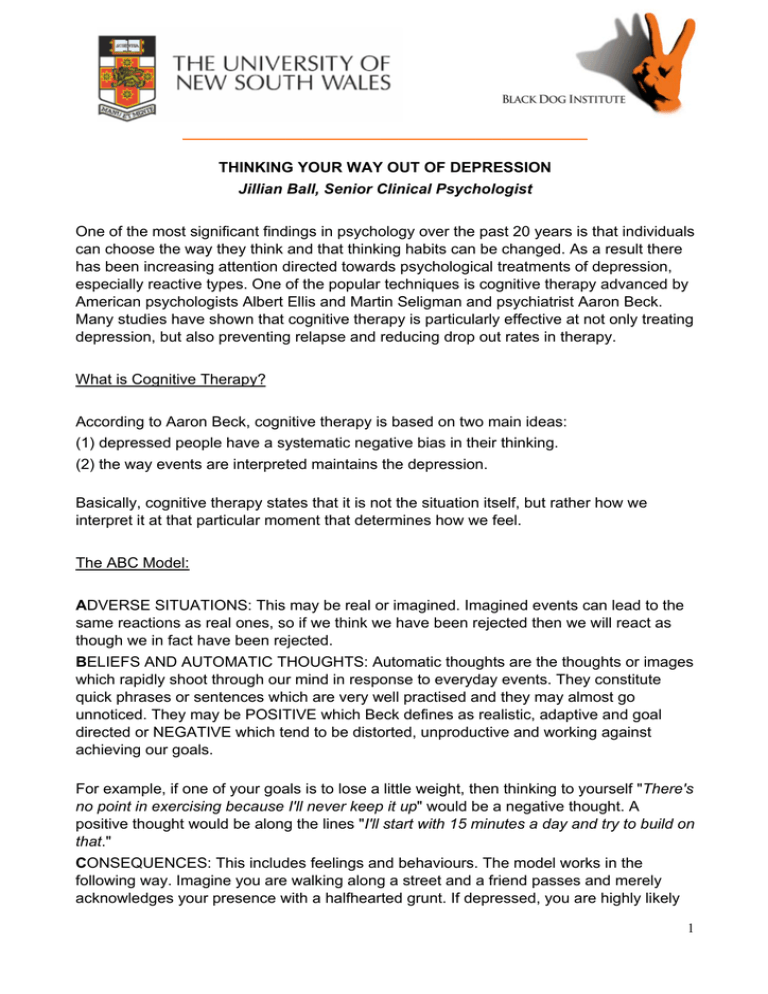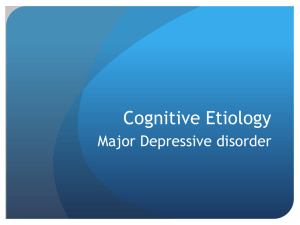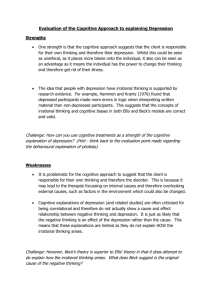Thinking your way out of depression (cognitive
advertisement

_______________________________________________ THINKING YOUR WAY OUT OF DEPRESSION Jillian Ball, Senior Clinical Psychologist One of the most significant findings in psychology over the past 20 years is that individuals can choose the way they think and that thinking habits can be changed. As a result there has been increasing attention directed towards psychological treatments of depression, especially reactive types. One of the popular techniques is cognitive therapy advanced by American psychologists Albert Ellis and Martin Seligman and psychiatrist Aaron Beck. Many studies have shown that cognitive therapy is particularly effective at not only treating depression, but also preventing relapse and reducing drop out rates in therapy. What is Cognitive Therapy? According to Aaron Beck, cognitive therapy is based on two main ideas: (1) depressed people have a systematic negative bias in their thinking. (2) the way events are interpreted maintains the depression. Basically, cognitive therapy states that it is not the situation itself, but rather how we interpret it at that particular moment that determines how we feel. The ABC Model: ADVERSE SITUATIONS: This may be real or imagined. Imagined events can lead to the same reactions as real ones, so if we think we have been rejected then we will react as though we in fact have been rejected. BELIEFS AND AUTOMATIC THOUGHTS: Automatic thoughts are the thoughts or images which rapidly shoot through our mind in response to everyday events. They constitute quick phrases or sentences which are very well practised and they may almost go unnoticed. They may be POSITIVE which Beck defines as realistic, adaptive and goal directed or NEGATIVE which tend to be distorted, unproductive and working against achieving our goals. For example, if one of your goals is to lose a little weight, then thinking to yourself "There's no point in exercising because I'll never keep it up" would be a negative thought. A positive thought would be along the lines "I'll start with 15 minutes a day and try to build on that." CONSEQUENCES: This includes feelings and behaviours. The model works in the following way. Imagine you are walking along a street and a friend passes and merely acknowledges your presence with a halfhearted grunt. If depressed, you are highly likely 1 to interpret this in a way that will make you feel worse. You may think that your friend is rejecting you and as a result you may conclude that "There is no hope for me. The whole world is giving me a hard time. No one really understands." However, if you are not depressed, you may think "Maybe he's preoccupied or having a bad day." What is evident in this example, is the depressed person's failure to look at other ways of interpreting the event. Cognitive Theory There are three aspects to Beck's approach to cognitive therapy: 1. THE COGNITIVE TRIAD: This explores the negative and biased views that the person has about himself, his experiences and the future. Various symptoms of depression can be explained using the Cognitive Triad. Poor motivation, for instance, can be seen to result from pessimism and helplessness. If we expect a negative outcome then we will not commit ourselves to a goal. Martin Seligman described helplessness as a state where you feel that nothing you do affects what will happen to you. This is the opposite to a sense of personal control. Many things in our life are beyond our control: our eye colour, race, civil wars in various countries. But there is a vast, unclaimed territory of actions over which we can take control. These include the way we lead our life, how we deal with others and so on. Our thoughts are merely reactions to events. For example, if we think we are helpless in getting a job, then we will be paralysed when approaching it. The thought "nothing I do matters" prevents us from acting. When we overestimate our helplessness, other forces will take over and shape our lives. 2. UNDERLYING BELIEFS OR SILENT ASSUMPTIONS: These are the templates or interpretive rules developed from early experiences which give rise to everyday thoughts or cognitions. They evolve from the messages we receive from parents, friends, schoolteachers and other significant people in our lives. The impact of parent's messages on their children's self esteem is receiving a lot more attention these days. These silent assumptions lead to certain biases in thinking due to a process of tuning into or screening out certain information. They cause us to attend to certain events, ignore others and to value and encode these events in certain ways. It is like a filtering system. I'll use a quiz to illustrate this notion further. “An empty bus leaves the depot for the day's run. On the first step it picks up 10 people...next stop it picks up 20 people...then it lets off 75 people...next stop it picks 2 up 10...after this 20 are let off. The question is: how many stops did the bus make?” If you attempted to add up the number of passengers on the bus you are not alone. This is a sensible and popular assumption you have made. It is difficult to attend to all the stimuli you have been given, so it is necessary to screen out some material and tune into what you judge or guess to be significant. It is the nature of the silent assumptions which depressed people make, without being aware of them, which maintains the depression. Examples of the subsequent belief systems which make people vulnerable to depression include: "I must get people's approval" "I must prove my worth through my achievements" "I must do things perfectly or not at all" "I must be valued by others or my life has no meaning" "The world must always be just and fair". Many people hold these beliefs to some degree but extreme adherence leads to misery and suffering. It is important when we treat people for depression, that we recognise these underlying beliefs and work directly at challenging them. Otherwise they tend to be latent and appear at various times under stress. Challenging Statements: "It feels good to be praised for what I do, but it is impossible to please everyone all the time. It is therefore important to judge for myself what I think is best and then be prepared to take the consequences." "My worth as person does not depend on my achievements. I am worthwhile because I exist." "Setting unrealistic standards only leads to procrastination and anxiety. I do not need to do things at 100% to get satisfaction and enjoyment.” "I may prefer to be in a loving relationship, but if I am not, it does not make me lessworthwhile. I do not need other people to feel good about myself." "It is frustrating when things don't go the way I would like, but I will get over it. I can accept, but not necessarily like the tact, that life is unfair." 3. INFORMATION PROCESSING: The cognitive model also asserts that depressed people make a number of distortions in the way they interpret information. Their information processing style leads to depression and passivity. Some common examples are: 3 ARBITRARY INFERENCES OR LOOPY CONCLUSIONS: This involves the tendency to draw a negative conclusion without sufficient evidence to support it. For example: "This is the second time my friend has interrupted me. She must think I'm a really dull person to talk to." All other possible interpretations are ignored. SELECTIVE THINKING: This involves focusing on negative details while ignoring the other positive aspects of the situation. It is like looking through Polaroid or dark coloured glasses. For instance, focusing on what you haven't done in a day rather than what you have done. OVERGENERALIZATIONS: This involves drawing over-sweeping conclusions on the basis of a single incident. There is the expectation that because something has gone wrong in the past, it will continue to do so. For instance, if someone lets you down in a relationship, you swear that you will never trust anyone again. Or thinking that your whole life is a mess rather than acknowledging you are still grieving the end of a relationship. MAGNIFYING AND CATASTROPHIZING: This involves exaggerating the importance of specific aspects of a situation such as believing that you would look like a complete fool after making one mistake. Catastrophizing is more extreme and involves fuming situations into disasters. For example, a headache means a brain tumour; if your partner is late home you believe that it must mean that they have been in a car accident. PERSONALIZING: This involves taking responsibility and blame for anything unpleasant that happens. For instance, believing that if someone is in a bad mood, then it is your fault. Low self esteem usually comes when people blame themselves unnecessarily for bad things that happen. DICHOTOMOUS OR BLACK AND WHITE THINKING: Thinking in extremes involves seeing everything in terms of "success" or "failure", "all or nothing" etc. It also involves setting unrealistic expectations and attempting to live by fixed rules, for instance, "I must never be late". It also encompasses the tendency to think in absolute terms such as "I won't be able to do it." In cognitive therapy we teach people to become proficient at detecting their distortions and immediately correcting them with statements such as: "This may be difficult, but I won't really know until I try." "Even if I don't win the tennis match, I can still enjoy the game." How Cognitive Therapy Works: RECOGNIZE THE NEGATIVE AUTOMATIC THOUGHTS: You first learn to recognise the automatic thoughts filtering through your consciousness at times you feel at your worst. For example, a mother sometimes screams at her four children when they head off to 4 school and she feels depressed as a consequence. In cognitive therapy she learns to recognise that right after these screaming incidents she thinks, "I'm a terrible mother. I'm not fit to have kids.” DISPUTE THE AUTOMATIC THOUGHTS: You learn to dispute the automatic thoughts by challenging with contrary evidence. The mother in the above example is helped to remember and acknowledge that when the children come home from school she plays with them, helps them with their schoolwork, feeds them and talks sympathetically to them about their problems. She is taught to focus on this evidence and to see that it contradicts her automatic thoughts that she is a bad mother. DEVELOP ALTERNATIVE POSITIVE EXPLANATIONS: You then learn to develop more realistic explanations. For instance the mother might say, "I'm usually good with the children, but sometimes in the morning I get cranky." DISTRACTION: It is then useful to learn to distract yourself from negative thoughts. This means stopping the negative ruminations and learning to control what you think and when you think it. DISPUTING THE UNDERLYING BELIEFS: The next step involves recognising and questioning the negative assumptions. For instance, replacing the belief: "I'm not good enough, I've failed as a mother" with "I do a lot for my children and love them very much. Sometimes I get upset with them but I am human and this is natural." Why Does Cognitive Therapy Work? Firstly, on a mechanical level it changes negative, pessimistic thinking styles to more optimistic and positive ones. It gives us a set of skills to stop the depression from taking hold. Secondly, on a philosophical level, it takes advantage of what Seligman refers to as ‘newly legitimised powers of the self’. It involves giving the mind a set of techniques for changing itself if it chooses. Who benefits from Cognitive Therapy? • People who have reactive depressions • People who have mild endogenous depressions: behavioural techniques can be especially useful • Bipolar illness - not during severe manic or depressive episodes but can be useful when the person is starting to settle. Useful to deal with psychological issues such as: readjusting to family, social and work commitments; how to live with the illness; restoring self confidence and self esteem. 5 Is cognitive therapy something that will last for one depression, or will it last all your life? Cognitive therapy has several aims. The first is to reduce the frequency and severity of episodes through early detection of symptoms and effective management. The second aim involves addressing the effects of the illness on your self esteem, identity and relationships. This reduces the vulnerability to psychosocial stresses which are a part of everyday life. Cognitive therapy is therefore a way of life. It is a way of thinking about and responding to mood changes and stresses with the best opportunity for a full recovery between episodes. It is possible that episodes of depression or mania might re-occur but the way of approaching them would be different. References Ball J. & Tanner S. Beating the Blues: A Self Help Approach to Overcoming Depression, Sydney. Tower. 1998. Beck A.T. Cognitive Therapy and the Emotional Disorders. New York. New American Library, 1976. Ellis A. & Harper R., A New Guide to Rational Living. Hollywood, Wilshire Book Company, 1975. Seligman M. Learned Optimism. Sydney. Random House. 1992. 6





